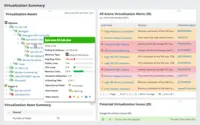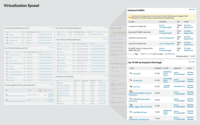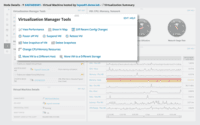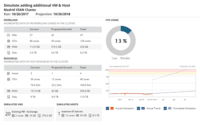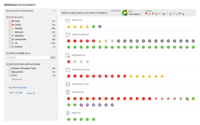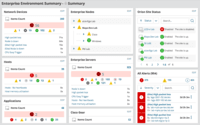Overview
What is SolarWinds Virtualization Manager (VMAN)?
SolarWinds® Virtualization Manager (VMAN) is a tool for monitoring, performance management, capacity planning and optimization for on-premises or cloud-based virtual environments. It also integrates with other SolarWinds products.
A necessity for any virtual environment!
SolarWinds VMAN Easy-to-Use Monitoring Virtual Environment
Single Pane of Glass for Infrastructure Monitoring
Great Alternative Tool to Manage Your VMs
Well suited for monitoring complex hybrid environments
SolarWinds VMAN - A Great Solution for Virtual Infra Management and Monitoring
SolarWinds VMAN is a Solid Product
SolarWinds Virtualization Manager (VMAN), helps do my job and saves me money at the same time.
For effective virtual administration VMAN offers more!!!
SolarWinds VMAN Powerful and Simple VM Monitoring
Wide Area Network Monitoring Tools
One of the best products
So instead of using VROPS and basic vCenter monitoring we using VMAN …
A virtual machine monitoring and management tool that helps you with remediations
Virtualization Manager
What else can be better than VMAN when mostly used Virtualization Vendor got covered
Awards
Products that are considered exceptional by their customers based on a variety of criteria win TrustRadius awards. Learn more about the types of TrustRadius awards to make the best purchase decision. More about TrustRadius Awards
Pricing
What is SolarWinds Virtualization Manager (VMAN)?
SolarWinds® Virtualization Manager (VMAN) is a tool for monitoring, performance management, capacity planning and optimization for on-premises or cloud-based virtual environments. It also integrates with other SolarWinds products.
Entry-level set up fee?
- No setup fee
Offerings
- Free Trial
- Free/Freemium Version
- Premium Consulting/Integration Services
Would you like us to let the vendor know that you want pricing?
13 people also want pricing
Alternatives Pricing
What is Citrix DaaS?
Citrix DaaS (formerly Citrix Virtual Apps and Desktops, or XenDesktop) is a virtual desktop infrastructure (VDI) and application virtualization solution from Citrix.
Product Details
- About
- Integrations
- Competitors
- Tech Details
- Downloadables
- FAQs
What is SolarWinds Virtualization Manager (VMAN)?
SolarWinds® Virtualization Manager (VMAN) is an intuitive tool for monitoring, performance management, capacity planning and optimization.
Complete visibility
into your environment
Manage both VMware and Microsoft environments - on-premises or in the cloud - with a single tool. VMAN also visualizes how your virtualization connects to application, server, and storage infrastructure for faster troubleshooting.
Clear path to maximize performance
Get insight into the performance, capacity, configuration, and usage of your virtualized infrastructure, including hosts, VMs, clusters and datastores. VMAN delivers recommendations to address active or potential performance issues.
Address virtualization issues efficiently
VMAN can execute a variety of management actions, including power on/off, suspend, reboot a VM, or take and delete snapshots. You can migrate VMs to a different host, and VM disks to a different data store.
Reclaim resources for improved performance
Reclaim virtual resources instantly with VM sprawl alerts and recommendations. VMAN can automatically find idle, stale, and zombie VMs as well as orphaned VMDKs to free up storage space. VMAN can guide you in right-sizing your VMs to recapture CPU and memory resources for further savings.
SolarWinds Virtualization Manager (VMAN) Features
- Supported: Hypervisor specific active alerting
- Supported: Virtual machine resource planning
- Supported: Actionable recommendations for remediation of active and predicted VM performance
- Supported: Visibility into VM Sprawl reclaims resources
- Supported: Remediate issues without having to log in to a hypervisor
- Supported: Intuitive dashboards that highlight the most important issues
SolarWinds Virtualization Manager (VMAN) Screenshots
SolarWinds Virtualization Manager (VMAN) Video
SolarWinds Virtualization Manager (VMAN) Integrations
SolarWinds Virtualization Manager (VMAN) Competitors
- Dynatrace
- Nutanix Cloud Infrastructure
- Turbonomic (formerly VMTurbo)
- VMware vROps
SolarWinds Virtualization Manager (VMAN) Technical Details
| Deployment Types | On-premise |
|---|---|
| Operating Systems | Windows |
| Mobile Application | No |
SolarWinds Virtualization Manager (VMAN) Downloadables
Frequently Asked Questions
Comparisons
Compare with
Reviews and Ratings
(123)Community Insights
- Business Problems Solved
- Pros
- Cons
- Recommendations
VMAN, a virtualization monitoring and troubleshooting tool, has proven to be an invaluable asset for customers in managing their virtualized environments. Users have relied on VMAN to monitor and alert on various aspects of their virtualized environment, such as disk space availability and newly created virtual machines - VMs. With VMAN, users have been able to identify issues with hosts and VM servers that are not visible in vSphere, providing deep insight beyond the capabilities of vSphere alone.
A key use case for VMAN is its ability to help users identify over or under provisioned VM servers and make resource adjustments as needed. The tool provides a single pane of glass view that includes storage and hardware information, giving users a complete view of their virtualized environment. This comprehensive view has allowed users to make informed decisions regarding resource allocation and upgrade planning.
Furthermore, VMAN has been instrumental in supporting IT operations teams in monitoring and managing virtual machines, ensuring proper resource allocation and identifying inactive VMs. It also assists in managing servers by providing important statistics, troubleshooting capabilities, and capacity planning. Through centralized alerting and troubleshooting across virtualization, server hardware, and network switching, VMAN empowers users to efficiently address performance issues and ensure smooth operation of their virtual infrastructure.
In addition to these core use cases, VMAN integrates seamlessly with other SolarWinds products, enabling users to monitor the entire virtualization structure and understand its impact on overall performance. This integration allows for proactive management of the environment by monitoring multiple sites and clusters.
Overall, VMAN simplifies the management of virtualized environments by providing deep insights into resource utilization, proactive monitoring capabilities, and streamlined troubleshooting. Its wide range of features has contributed to improved efficiency, reduced downtime, optimized resource allocation, and enhanced overall performance for many organizations.
Emailed alerts: Users have found the emailed alerts provided by VMAN to be fantastic, with multiple reviewers expressing their satisfaction. This feature allows users to stay informed about important events and issues related to their virtual infrastructure, ensuring prompt actions can be taken when necessary.
Customizable dashboards: The ability to customize dashboards has been highly regarded by users of VMAN. This functionality allows them to tailor the display of information according to their specific monitoring needs and preferences, providing a more personalized and efficient monitoring experience.
Comprehensive range of features: Reviewers have praised the comprehensive range of features offered by VMAN for virtual infrastructure monitoring. They appreciate that VMAN provides a wide variety of tools and capabilities such as capacity planning, performance management recommendations, configuration management, chargeback automation, and managing across on-premises, hybrid, and cloud environments. This extensive feature set ensures that users have all the necessary resources at their disposal for effective virtual infrastructure management.
Licensing Cost: Several users have mentioned that the licensing process of SolarWinds is easy but costly, and they suggest that it could be improved to provide better value for money.
Setup Issues and Unhelpful Support: A number of users have experienced difficulties during the setup of SolarWinds, particularly with connecting to hosts and vCenters. They felt that the support team was unhelpful and only directed them to articles they had already read.
Navigation and Integration Challenges: Users have found the navigation in the VMAN console to be difficult and time-consuming, suggesting that it needs improvement. Additionally, there are ongoing issues with the lack of integration between VMAN and the main SolarWinds Orion console.
Users commonly recommend the following three suggestions for SolarWinds Virtualization Manager:
-
Customize the product by taking advantage of customization options offered by a partner or SolarWinds to tailor the product to their specific needs. This allows users to optimize the functionality of Virtualization Manager and make it more aligned with their requirements.
-
Utilize online training and community support by leveraging online training resources provided by SolarWinds and actively participating in the thwack community. These platforms offer valuable insights, best practices, and troubleshooting assistance from other users and experts, enhancing the overall experience with Virtualization Manager.
-
Maintain VMs/hosts regularly by ensuring regular maintenance of virtual machines (VMs) and hosts. Staying on top of maintenance tasks such as updates, patches, and monitoring performance is crucial for maximizing the benefits of Virtualization Manager. By doing so, users can effectively manage their virtual infrastructure and achieve optimal results.
By implementing these recommendations, users can further enhance their usage of SolarWinds Virtualization Manager and fully leverage its capabilities for their virtualization needs.
Attribute Ratings
- 8.6Likelihood to Renew7 ratings
- 8.2Availability1 rating
- 6.4Performance1 rating
- 9Usability7 ratings
- 8.8Support Rating6 ratings
- 9.1Implementation Rating3 ratings
- 10Configurability2 ratings
- 9.1Product Scalability1 rating
- 8.2Ease of integration1 rating
- 10Vendor pre-sale2 ratings
- 10Vendor post-sale2 ratings
- 9.3Solarwinds Premier Support Rating9 ratings
- 3.5SolarWinds Smart Start Support Rating2 ratings
Reviews
(1-25 of 28)A necessity for any virtual environment!
- VM sprawl management
- Capacity planning
- Performance management
- visibility across all of our datacenters
- N/A
Single Pane of Glass for Infrastructure Monitoring
- Integrates with other SolarWinds Products
- Integrates to monitor Third Party Products
- Provides capacity planning predictions
- VM management across multiple platforms
- Performance optimization for web interface
- More modular services
- Integrated reporting plugins
- More mature scripting abilities
- Virtual Infrastructure Monitoring
- Capacity Planning
- Dashboards
- Better Dashboards for cloud providers
- Detailed documentation
For effective virtual administration VMAN offers more!!!
- Real-time virtual machine and hardware health status.
- Comparison between consumption of processor and memory usage of the Hosts against the consumption of memory usage and processors of virtual machines.
- Consumption of processor, memory, and storage usage across clusters in real-time.
- Veeam integration for direct backups from Orion for guest OS.
SolarWinds VMAN Powerful and Simple VM Monitoring
- Performance Management
- Recommendations
- Virtualization Sprawl
- VMWare Events
- Additional OOB Reports
Virtualization Manager
- It helps us determine where problems are and helps us determine what is a good cloud candidate.
- Better performance.
What else can be better than VMAN when mostly used Virtualization Vendor got covered
- Hierarchal representation of the assets such as DC, Cluster, Host and VMs
- Sprawling Features
- Datastore Monitoring
- Nuatanix Environment needs more parameters
- Capacity Reporting and integration with Storage
- Include more vendor support
SolarWinds Virtualization Manager helps buisness go forward
- Recommendations. Those are wonderful. You build out your environment based on a set of criteria from a vendor or others, only to find your resources are poorly used. The VMAN product allows you to make adjustments based on its recommendations and it automates the process for you.
- Pinpoints guests with problems. It provides a graphical and then drills down details to the virtual guests with issues you need to address immediately.
- Capacity planning and sprawl. VMAN gives you all the tools you need to prvent sprawl and plan for the future.
- Licensing. One of the most glaring elements to SolarWinds is the way they license. I feel they could improve this a bit. It a easy process just costly.
- They tell you about orphaned VMDK but don't tell you where it might be used. It says it might be, I feel it should check.
Look forward to using long term
Its in depth coverage also allows us to identify wasteful resources and maximise our efficiency bringing real savings to infrastructure on premise costs.
- In depth VM and Host coverage, particularly metrics such as CPU ready time, no more calculations working out % based on ms latency - its all available at glance of a chart.
- Coverage of both SAN and VM environments compliments eachother really well allowing us to diagnose any bottle necks within 15 minutes compared to an hour prior to using SW VM.
- Custom dashboards allows all our engineers to customise their NOC views allowing the umbrella departments to quicker respond or be able to proactively work with other departments to avoid downtime.
- AWS coverage, not had major chance to research but seems to lack native compatibility for AWS specific services - such as ECS / Cloudfront metrics etc.
- Some container technologies such as Docker, again not had much time to research but upon first investigations doesn't seem as native to implement monitoring compared to say VMware.
- AD deep dive monitoring - replication times etc.
Also as per previous point with regards to container workloads. Not sure if agent of some form is being developed we could include in container images relatively easily?
Home for the SysAdmin
- Optimisation of resources used
- Forward capacity planning
- Problem resolution
- Improved graphical displays
- Analyses of groups of servers
Highlighting over provisioned servers
- The capacity planning tools have been very helpful to see where we stand, and to prepare for new workloads and growth
- The virtualization alerts are pretty helpful in responding to issues and assisting with troubleshooting
- The Virtualization manager tools are a nice way for our IT managers to see everything at a glance, and get some detailed information
- I would like more options of things that can be displayed or tracked on the dashboard
- The reports are a little clunky or confusing to setup, especially custom reports
- Overall it does what we need, I really don't use it as much as other staff here
Brief but to the point
- The proactive monitoring.
- Ability to troubleshoot issues.
- Reporting on usage.
- Future planning for HDD space.
- Very costly.
- Resource utilization on the server it resides.
- Lack of reporting on EtherChannel.
VMAN, hyperconverged utilization/performance monitoring
- VM capacity planning
- VM forecasting
- VM monitor multi hyperconverged
- VM capacity advisor
- More vendor could be covered
SolarWinds is a great tool for monitoring software
- Detail performance stats.
- Good alert system.
- RAM management poor.
- Capacity planning could be wider, not server specific.
Trying to wrangle your private cloud environment? Never send a child to do the work of a VMAN!
- Beautiful inventory of the guests and hosts running in a cluster, and how they are organized in your environment
- Own other SolarWinds modules like SRM, APM, etc? AppStack puts everything in a single, lineage view.
- Automates tasks for non-admins and/or run teams -- vMotion? Yep. Shutdown a VM? Sure.
- Latest version integrates beautifully with Orion. No more running virtual appliances. Everything is built on the Orion framework!
- Want to build alert? The Orion alerting engine is easy to use, intuitive, and supports SQL, SWQL, and drag/drop alert logic definition.
- VMware is the platform that gets top billing. HyperV is supported, but is a 2nd class citizen
- We encountered duplicate instances of VMware hosts. It was a pain to clean up
- Credential manager hasn't been updated since -- forever. Investigating authentication issues/managed host issues is an exercise in futility.
Regardless of the size of your environment, from a single cluster with a few hosts, to multiple virtual data centers, housing dozens and dozens of clusters, with thousands of VMs, VMAN can scale to give the insight needed. It did for us!
VMAN is the Man
- The volume of data available from Virtualization Manager out of the box is huge. We were shocked at the amount of issues we had that Virtualization Manager highlighted within the first few days.
- The ability to add additional widgets into seperate screens giving valuable VM and host insight.
- The recommending/reporting element is fantastic and we use it daily to keep track of whats changing in our VM environment.
- We did have issues during the setup, with successfully connecting to some of our hosts and vCenters and we found support were just sending us back to articles we had already read, it was also taking long periods before getting a response. The issue is still ongoing, in fact.
Essential for a solid Virtual environment
- I created custom dashboards, to view the different elements of the virtual environment. For example, you can view the number of online VMs and those off, or disconnected. You can also choose to see the status of every virtual cluster, the storage disk usage on every VM, the RAM usage, CPU usage.
- I used this application to see the growth of virtual memory in each cluster and accordingly do forecasting for future growth. A capacity planner included in this application would help in doing accurate estimations and setting a future upgrade budget.
- Another powerful tool was the customized reports, where i could generate reports on any element of the VM or cluster. Reports can be exported to Excel or PDF and are very useful for sharing information with colleagues and management.
- Alerts can be customized. For example, you can set a rule to get an email alert if any virtual server RAM usage exceeds 85% and send a text message if RAM usage exceeds 90% for more than 10 minutes.
- Generating a new license key upon renewal and then installing the new key is not a straightforward process. I think license renewal should be handled using easier methods
- Solarwinds VMAN is a VM itself, so in case the cluster or ESX/host where it resides fails, there won't be a way to get alerted.
- There account managers are really annoying, every year they start calling and sending emails 3 month before renewal.
- It is perfectly suited for environments with 100+ virtual servers. It is essential in environments with several clusters and 500+ virtual servers.
- It would be optimal for hybrid environments with Hyper-V and VMware.
- It can be expensive for small businesses.
- It is not recommended in case most of the environment is on physical servers or cloud platforms
SolarWinds VMAN Review - A service provider perspective.
- VMAN's powerful sprawl analyses allows businesses to see where their hypervisor estate can be made more efficient. Coupled with powerful capacity management, the efficiency gains allow the product to quickly start returning on it's investment, allowing businesses to do more with what they already have.
- The recommendations provided by VNMAN allows administrators to schedule changes in compute, storage assignment, and host/guest balance. These changes can be automated to take place on a schedule to suit, with VMAN making the changes at the appropriate time, allowing businesses to potentially save on expensive out of hours administration.
- It's not only on-premise! With VMAN you can monitor your cloud-based guests on Amazon EC2 and Microsoft Azure.
- Whilst VMware vSphere and Microsoft Hyper-V are the two big hitters in the hypervisor estate, VMAN lacks support for other popular solutions, such as Citrix XenServer, Oracle VM.
Solarwinds VMAN, doing the job no other module can
- Capacity planning in storage.
- Recommendations to improve environments.
- Separate VMWare and Hyper V specific tools.
- Recommends migration of VMs across hosts to even out workload
- Alerts us on unused resources and suggests what can be taken away from which systems
- Predicts growth so you can plan for expansion
- some times we get false reports of Zombie VMs but that is not often at all
We are using Solarwinds VMan to monitor our entire virtualisation estate including Hyper-V and VMware.
We use it to address estate capacity, load balancing, alerting and troubleshooting.
- Capacity planning is excellent for planning ahead for new projects and future expansion.
- Finding bottlenecks within the estate and quickly rectifying lack of CPU, RAM and storage.
- Virtualisation recommendations is particularly good for load balancing resources across the estate.
I find planning ahead using the capacity planning tab one of the most helpful parts of VMan, we often get projects that have not had storage considerations discussed and we have to quickly find available capacity or charge for additional resources to be purchased.
I feel the environment map could be improved along the lines of other type 'network' style maps.
SolarWinds Virtualization Manager- saves time and money
- Customizable dashboard, giving you only the information you want to see (of course, it's only as useful as the time you put into configuring it.)
- Customizable email notifications (once again- you have to know what you want to report on, and specify that explicitly.)
- It also provides capacity management, but this has never been an issue for us, so I haven't really utilized this feature.
- I would like to see a little more intelligence built into the application. More out of the box reports, notifications and displays that are useful without needing built by the customer. It seems that most Sys Admins are all looking for the same information and notifications- why not have a few build a very useful dashboard, and have that be the default- and then still allow for further customization?
SolarWinds Virtualization Manager has it's Pros and Cons
We're using the product for a consolidated view of our VMware and Hyper-V environments in the UK. We integrate VMAN into our current Orion solution for detailed information on our servers and storage. We also make use of out of the box alerts and recommendations to maintain the platforms.
- Detailed server / storage information and performance statistics.
- Alerts.
- Recommendations, particularly on right sizing.
- Single pane of glass for virtualized environments.
- Dashboard widgets - Sorting lists by column headings is not available in all views.
- Hyper-V needs more attention in general. But being able to group servers by Clouds, Host Groups, Replication status, Mainenence mode, host status etc. need to be added.
- Capacity management could do with the ability to report on entire enviroment and not just a single cluster.
- Hyper-V Recommendations – Memory – There should be a clear distinction between static and dynamic RAM. And actions should not mention or perform reboot if dynamic and not required.
Overseeing the virtualizing of my life.
Virtualization manager especially provides us with at-a-glance monitoring of cluster and host loads. With multiple host operating systems and topologies this saves a lot of logging into individual systems to check performance and errors.
- At-a-glance views of current problems and potential future problems.
- The recommendations feature is fantastic. This helps us balance loads and look for soon to be problems on multiple devices in a single place. There are very few false positives.
- Easy to set up and maintain. Out of the box the system connects to major vendors and begins monitoring with minimal hassle. There's no manual set up of agents, monitoring points or set up of the monitoring console.
- With the SolarWinds Orion support you can easily add virtualization features to NOC screens and servers node pages. Alerts are tied in as well to reduce hassle of multiple alert managers.
- Server trending could be stronger. A server which sits at the same resource usage day in and day out can be normal operation while Virtualization manager may report it as an issue.
- Orion in general can be painful to change a node page with the desired screens and widgets
If you're working with a small environment it may be more costly than the value provides. It really shines with larger environments.
Works will with our monitoring products.
- Gives me useful detail on every object and the ability to drill into more detailed data is great.
- The ability to predict when resources will become constrained.
- Emailed alerts that and the ability to customize them.
- Licensing. Difficult- expensive- constant sales cycle

